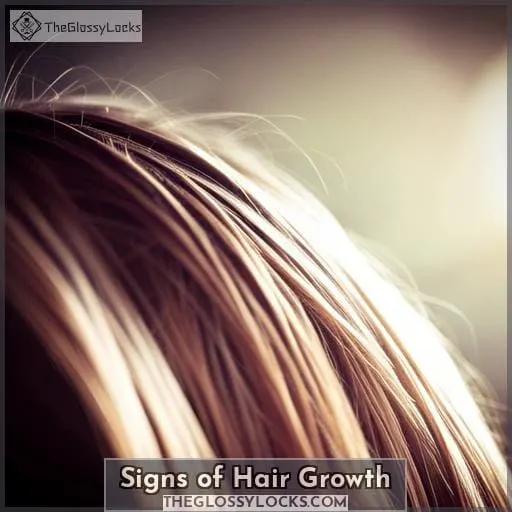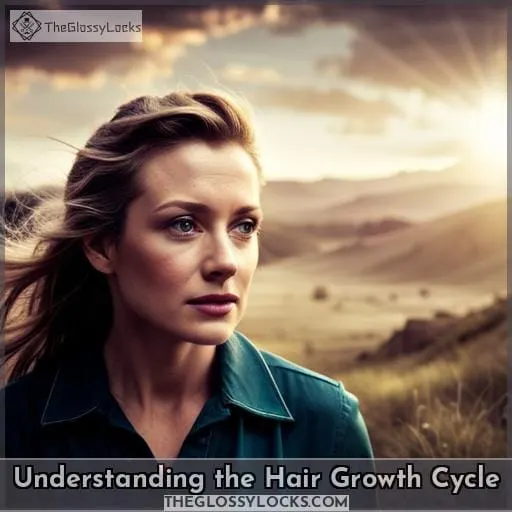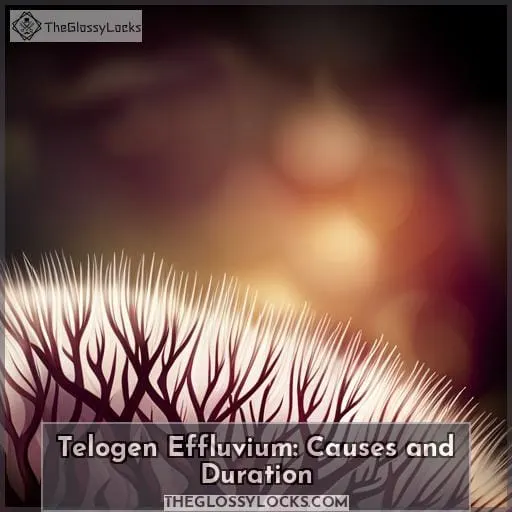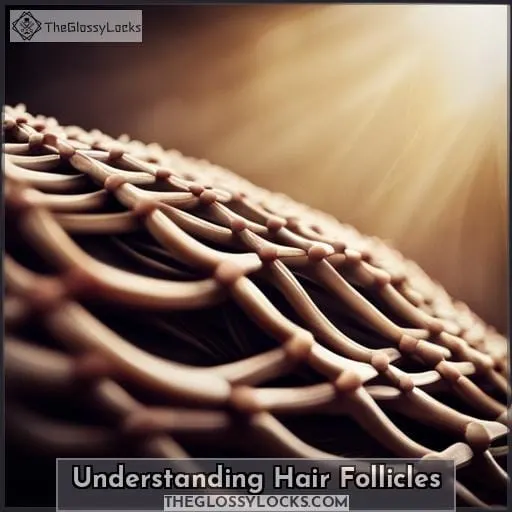This site is supported by our readers. We may earn a commission, at no cost to you, if you purchase through links.
 Do you feel an annoying itch on your scalp as your hair grows? That could be a sign of Telogen Effluvium, a condition that affects up to 70% of people’s hair growth. While it may be uncomfortable and irritating, understanding why this happens can help you prevent or treat the issue so that it doesn’t interfere with growing healthy locks.
Do you feel an annoying itch on your scalp as your hair grows? That could be a sign of Telogen Effluvium, a condition that affects up to 70% of people’s hair growth. While it may be uncomfortable and irritating, understanding why this happens can help you prevent or treat the issue so that it doesn’t interfere with growing healthy locks.
In this article, we’ll explain what signs indicate new strands are sprouting from your head and detail the three phases of the hair growth cycle – Anagen, Catagen, and Telogen. We’ll also explore causes for telogen effluvium in more depth. Additionally, we’ll discuss who is most at risk for developing telogen effluvium as well as how it impacts body functions such as shedding patterns and follicle appearance.
Finally, learn how to identify different types of follicles by their color, size, and composition too! Join us now to get informed about all things related to itching scalps when our tresses are growing!
Table Of Contents
Key Takeaways
- Itchy scalp may signal hair growth.
- Telogen Effluvium can cause itching and hair loss.
- Rapid hair growth suggests healthy follicles.
- Baby hairs near the hairline indicate regrowth.
Signs of Hair Growth
If you have noticed a dark patch on your head or some baby hair sprouting up, it is possible that your scalp may be itching because of new hair growth. This could signal the start of the Anagen phase – the stage in which most hairs are actively growing and when follicles typically appear darker than usual due to an increased blood supply.
Dark Patch of Hair on Head
If you’ve noticed a dark patch of hair on your head, it could be an indication of healthy follicles in the anagen phase and potential regrowth. An itchy scalp is another sign — a tingling sensation or itchiness signals new hair growth.
Dark spots are also present around follicles, while thinning may occur due to shedding during this time. Baby hairs near the hairline show successful regrowth from telogen effluvium or other forms of temporary hair loss.
Baby Hair on Adults
You may notice the appearance of fine, wispy strands near your hairline signaling potential regrowth. Adult baby hair is often soft and translucent. It’s a sign of new growth in the Anagen phase. Hair care tips such as using gentle shampoos are important during this process. A tingling scalp can indicate inflammation or new hair growth.
Hair texture, styling tips, and psychological impacts should all be taken into consideration when going through the regrowth process.
Scalp itchiness does not necessarily mean that you’re experiencing hairs growing back but could signify other things like inflammation. It’s best to consult with your doctor if you experience changes in your scalp health or before trying any chemical treatments on your newly grown baby hairs.
Rapid Hair Growth
Rapid hair growth is often a sign of healthy follicles, and you can spot it by feeling tingles. Promoting rapid regrowth requires balanced nutrition with high-quality protein. Stress-related shedding affects up to 70% of anagen hair, so cope with changes fast! Hair myths abound, but scalp health tips help balance the natural cycle and avoid damage.
Little Hair Shedding
Little shedding is a sign of healthy, growing hair. Scalp itch may indicate inflammation or new growth.
Tingling Scalp
Feel a tingle radiating through your scalp, like electricity sparking in the night sky – it’s a sign of new life. Itchy sensations may be caused by stress or telogen shifts but can also indicate healthy hair follicles and regrowth.
Care for your scalp with gentle cleansers to help promote growth; dark spots around follicles mean color is returning! Structure and texture will vary as well: thin wisps near the hairline are common during this process.
Understanding the Hair Growth Cycle
Are you curious about the hair growth cycle? Hair follows a life cycle that consists of three phases: Anagen, Catagen, and Telogen. During the Anagen phase, active cell division occurs at the base of each follicle as new hairs begin to grow.
The Catagen phase is transitional; it marks an end to active growth and signals for less activity from cells in preparation for shedding old hair during Telogen. In this resting stage, older hairs will eventually fall out before being replaced with new ones in subsequent cycles.
Anagen, Catagen, and Telogen Phases
You may notice your hair transitioning through the Anagen, Catagen, and Telogen phases as it cycles through its life cycle. During Anagen, insights suggest rapid growth is indicative of healthy follicles.
Catagen mysteries lead to shedding or dormant hair. Telogen Troubles manifest in increased shedding and a shift from an active to resting phase.
Hair Growth Myths abound, but understanding these signs can help you identify potential issues with scalp sensations like tingling. This could be linked to new regrowth or inflammation due to acute telogen effluvium.
Characteristics of Each Phase
During the anagen phase, hair is actively growing and can reach a length of up to four years, making it the longest stage in the cycle. Characteristics include dark patches around follicles and a rapid growth rate, indicating healthy follicles.
The catagen phase sees a gradual slowing down of growth as strands prepare for telogen.
During telogen, most hairs are resting before they shed off during exogen within one to four months.
Lastly, shedding rapidly indicates telogen effluvium caused by stressors that shift active anagen hairs prematurely into rest mode.
Telogen Effluvium: Causes and Duration
Telogen effluvium is a common cause of hair loss that affects both men and women. It comes in two forms: acute telogen effluvium, which usually lasts for under six months, and chronic telogen effluvium, which can last beyond six months.
Acute Telogen Effluvium
When stress takes a toll, your body can push up to 70% of anagen hair into the resting phase, called telogen effluvium.
Common symptoms include rapid shedding of up to 300 strands per day – often from the top of the head – as well as scalp discomfort such as itching sensation or tenderness.
Regrowth usually begins 2-3 months after initial onset; however, triggers such as hormonal changes and other physical shocks can cause further episodes throughout life.
To help prevent long-term damage due to this condition, it’s important to manage stress levels through restful sleep, healthy dieting habits, and exercise while avoiding harsh chemicals on your scalp that may inhibit regrowth and trigger more severe reactions like chronic TE instead!
Chronic Telogen Effluvium
Chronic telogen effluvium can cause up to 300 strands of hair loss per day, often on the top of your head. It may lack a clear cause and typically doesn’t lead to total baldness. You might feel tingling sensations in your scalp or experience other emotional impacts.
To cope with chronic TE, consider these strategies:
- Use hair care tailored for sensitive scalps.
- Take biotin supplements.
- Protect your scalp from the sun.
- Explore treatment options such as cold caps or alternative solutions like scarves instead of wigs.
Be aware that some treatments may not work effectively unless approved by a doctor first, especially when dealing with cancer treatments causing hair loss!
Seize control over this condition and explore what works best for you personally so you can manage it successfully without compromising wellbeing along the way!
Who is Affected by Telogen Effluvium?
Telogen effluvium is a type of hair loss caused by physical or psychological stressors. It affects many individuals, with certain risk factors and common demographics making some more susceptible to its effects.
Risk Factors
You may be more likely to experience telogen effluvium if you’re a female or AFAB individual between the ages of 30-60, so it pays to keep your eyes peeled. Hair growth risk factors include stress-related triggers and chronic onset issues.
Telogen effluvium causes can range from hormonal changes, poor nutrition, weight loss, and illness – as well as certain hair care practices like overstyling or chemical treatments.
Demographic influences, such as age, also play an important role in increasing susceptibility to this condition. However, anyone at any stage of life can be affected by telogen effluvium, regardless of gender identity or lifestyle choices.
Common Demographics
Generally, telogen effluvium is most common among AFAB individuals aged 30-60. It can be caused by a wide range of stressors and affect both the scalp and body hair, although it rarely results in total baldness or affects the hairline.
Those affected may experience up to 300 strands of hair lost per day due to rapid shedding not associated with patterned loss. This condition usually progresses slowly and has different psychological effects.
Treatment options include managing underlying stressors through lifestyle changes such as improved nutrition, exercising regularly, and getting proper restful sleep. Seeking professional help for addressing anxiety and utilizing various relaxation techniques like yoga or meditation can also be beneficial.
Learning mindfulness approaches towards managing emotions better and engaging in self-care activities that bring joy into one’s life, such as getting regular haircuts at a salon instead of doing them oneself during stressful times, can also help.
It is recommended to use gentle, chemical-free cleansing products like baby shampoos when needed.
How Telogen Effluvium Affects the Body
Telogen effluvium is a form of hair loss that affects many people, regardless of age or gender. It causes an increase in shedding and changes to the pattern of hair loss, which can be alarming for those affected.
Impact on Hair Shedding
With telogen effluvium, hair shedding can be like a torrential downpour – sudden and intense. Stress or body changes cause up to 70% of anagen hairs to move into the resting phase, resulting in more than 300 strands lost per day.
Though it rarely affects eyebrows or baldness, severe cases may involve other body hair as well.
Scalp itchiness during this process is common for many individuals; however, relief solutions are available, such as gentle cleansing products and biotin supplements (after consulting your care team).
Hair Loss Patterns
Experiencing hair loss in a patterned way can be an indication of telogen effluvium.
- Scalp itching due to inflammation and/or new growth
- Changes in the rate or texture of hair regrowth over time
- Unusual sensitivity when caring for scalp health.
It’s important to note that while scalp itching may indicate new growth, it isn’t always present. Additionally, different stresses can affect how quickly you see results from any treatments used for telogen effluvium recovery; some people will experience faster regrowth than others depending on their individual situation.
The best approach is to carefully monitor your progress and modify your treatment plan as needed based on changes observed in the overall state of your scalp health and hair care routine.
Understanding Hair Follicles
You may be wondering about the appearance, color, size, and composition of hair follicles. Hair follicles can vary in shape – some are curved while others are straight – and usually range from 0.
Color-wise, hairs that have just emerged from a hair follicle tend to be darker than those further along in their growth cycle as they age and move higher up on your head towards the surface of your skin.
On top of this, each individual strand is composed mainly out of protein called keratin along with small amounts of other materials such as fats, which give it its strength and flexibility, respectively.
Appearance of Hair Follicles
Check for tingling sensations alongside dark spots, baby hair, or soft and translucent strands as signs of potential regrowth. A balanced diet can help support this process by giving the follicles what they need to survive stress-induced shedding.
Follicle appearance may also give clues into how an individual’s body is dealing with stress impacts. Wispy hairs near the hairline could indicate regrowth, while texture changes suggest a different response to treatment or aging.
When assessing scalp sensation for potential growth, look for tingling in addition to other cues like peach fuzz or thinning patches at the crown area.
Ultimately, personal preferences will influence which strategies are most effective when managing telogen effluvium-related hair loss.
Color of Hair Follicles
Feel for differently colored strands near the hairline, as this may indicate newly growing follicles. Hair follicle pigmentation can vary due to melanin influence and produce a range of colors in the shafts.
Size of Hair Follicles
Gently rub your scalp to explore the size of each hair follicle – from tiny, delicate strands near the hairline to thicker ones further back. Hair density and texture can vary greatly depending on core factors such as genetics or hormonal balance.
Healthy scalps have a balanced mix of sizes and densities that promote optimal growth conditions. Factors like diet, stress levels, and medications may also influence follicle size and thus affect overall hair health in both positive or negative ways.
Composition of Hair Follicles
Examine the composition of your hair follicles to get a better understanding of what’s happening underneath the surface – it may be like putting two and two together.
Hair follicle structure consists of several components, such as melanocytes, sebaceous glands, arrector pili muscles, and stem cells. These parts work in synergy with growth factors to ensure healthy regrowth and regeneration over time.
Factors that affect follicle health include hormones, age-related changes, or illness; poor nutrition can also lead to weakened strands or stunted growth.
Unlocking deeper insights into how these elements interact will help you better understand why your scalp may itch when hair is growing back thicker than before!
Conclusion
It’s estimated that up to 70% of anagen hair can enter the telogen phase due to stress, resulting in telogen effluvium. This form of hair loss can cause up to 300 strands of hair to be shed per day, often on the top of the head.
While it rarely affects the hairline or causes total baldness, severe cases may impact eyebrows and body hair.
It’s also important to note that a tingling scalp can indicate inflammation or new hair growth, so it’s worth paying attention to any signs of itching when your hair is growing. However, the absence of tingling doesn’t rule out hair growth, so if you’re noticing dark patches, baby hair, or peach fuzz, there’s a good chance your hair is in the process of growing back.









